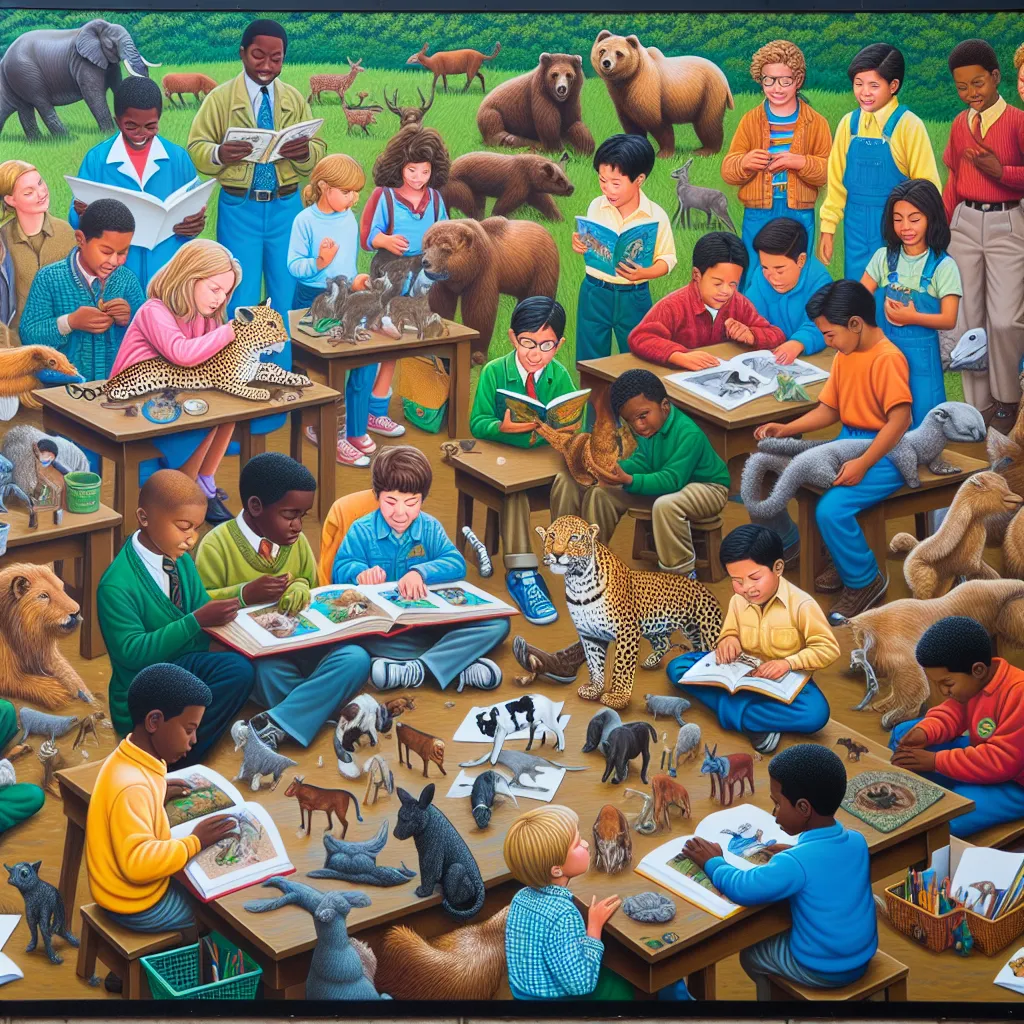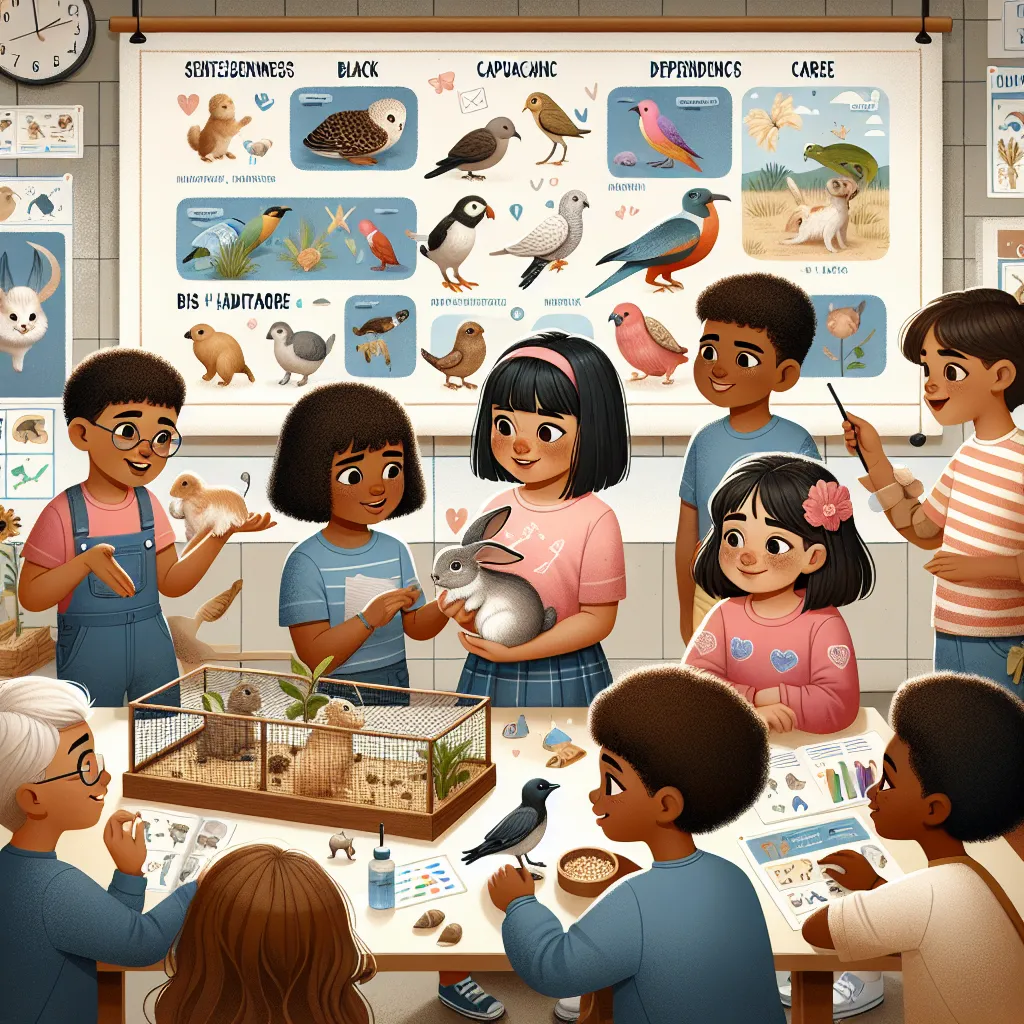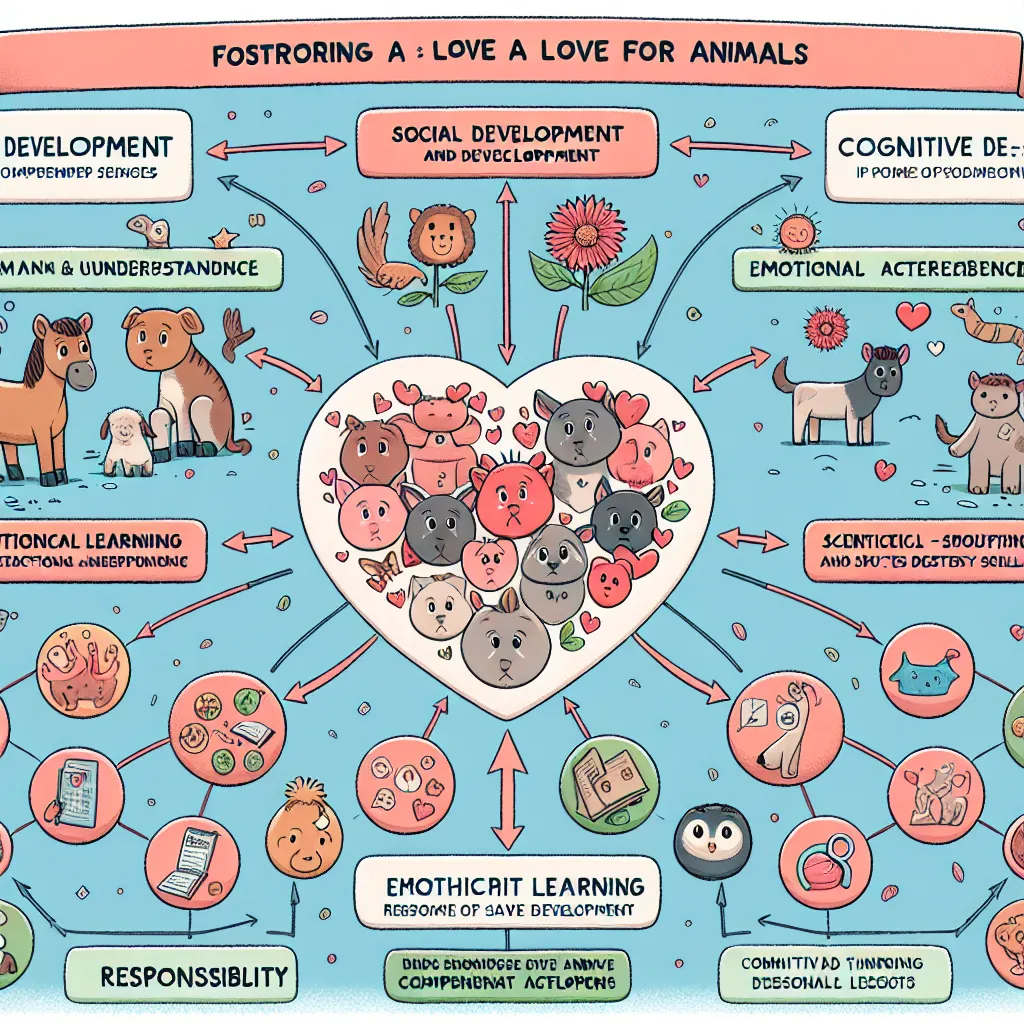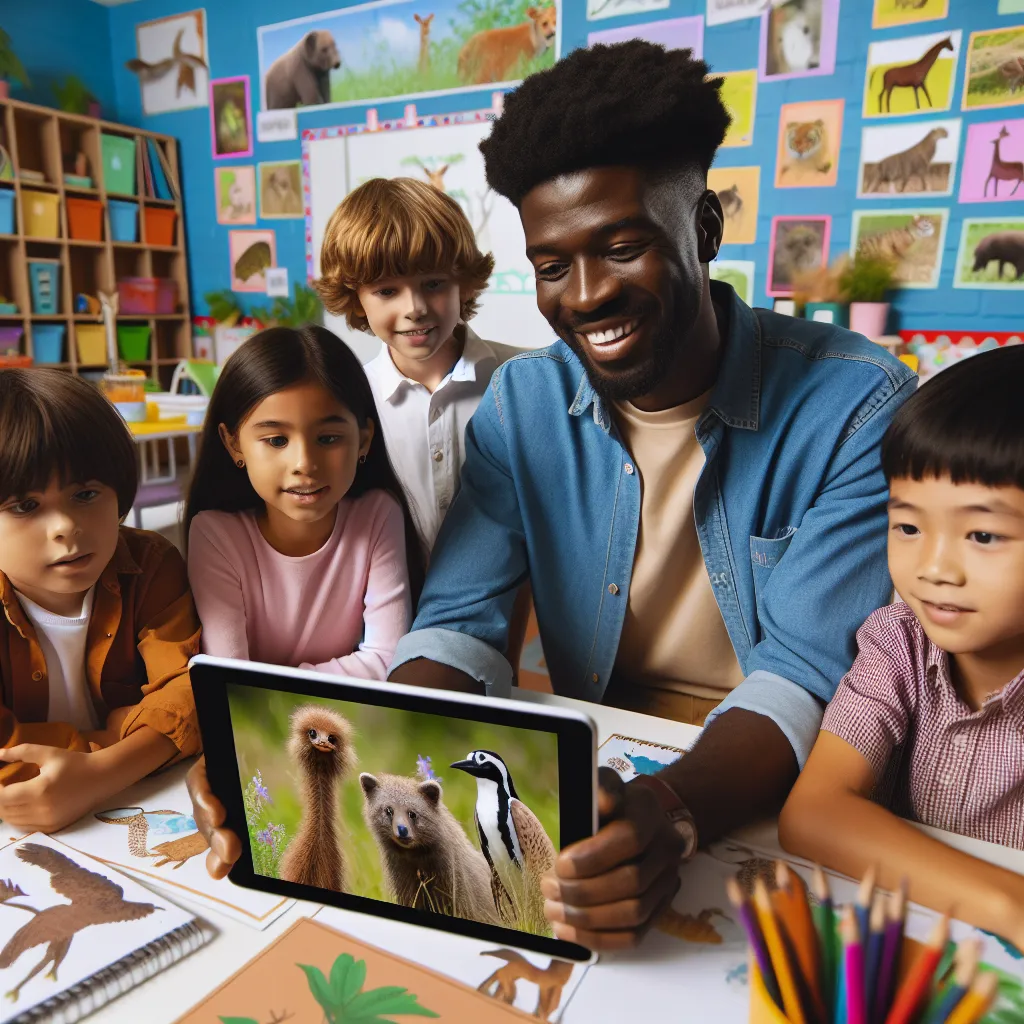Ask AI on The Internet
Question: Please convert the following information into Essay,do not include sub headings : Fostering a sense of compassion and love for animals in children is important for several reasons: 1. Promotes empathy and understanding: Learning about animals and their needs helps children develop empathy and understanding towards all living beings. 2. Encourages responsibility and care: Caring for animals teaches children important life skills like responsibility, nurturing, and compassion. 3. Develops emotional intelligence: Interacting with animals helps children understand and manage their emotions, developing emotional intelligence. 4. Supports social skills: Interacting with animals and other animal lovers helps children develop social skills like communication, cooperation, and friendship. 5. Fosters a sense of wonder and curiosity: Learning about animals and their habitats encourages children to explore and appreciate the natural world. 6. Encourages kindness and compassion: Treating animals with kindness and respect teaches children the importance of compassion and empathy towards all living beings. 7. Supports learning and education: Learning about animals and their habitats can be a fun and engaging way to learn about science, biology, and the natural world. 8. Helps develop critical thinking: Learning about animals and their needs encourages children to think critically about the impact of human actions on the environment and animal welfare. 9. Encourages environmental awareness: Learning about animals and their habitats teaches children about the interconnectedness of species and the importance of protecting the environment. 10. Supports personal growth and development: Fostering a sense of compassion and love for animals in children can contribute to their overall personal growth and development, teaching them valuable life skills and values. By fostering a sense of compassion and love for animals in children, we can help them develop important life skills, values, and empathy, ultimately contributing to a more compassionate and responsible society.Developing a love of animals can contribute to students' overall social, emotional, and cognitive development in several ways: Social Development: - Empathy and compassion: Learning about animals and their needs helps students develop empathy and compassion towards all living beings. - Responsibility and care: Caring for animals teaches students important life skills like responsibility, nurturing, and compassion. - Social skills: Interacting with animals and other animal lovers helps students develop social skills like communication, cooperation, and friendship. Emotional Development: - Emotional intelligence: Interacting with animals helps students understand and manage their emotions, developing emotional intelligence. - Self-awareness: Learning about animals and their needs helps students develop self-awareness and understanding of their own emotions and needs. - Stress relief: Interacting with animals can help students reduce stress and anxiety. Cognitive Development: - Learning about animals and their habitats can be a fun and engaging way to learn about science, biology, and the natural world. - Critical thinking: Learning about animals and their needs encourages students to think critically about the impact of human actions on the environment and animal welfare. - Problem-solving: Caring for animals teaches students important problem-solving skills like providing food, shelter, and healthcare. By developing a love of animals, students can experience a range of benefits that contribute to their overall social, emotional, and cognitive development. This can lead to a more well-rounded and compassionate individual, with a deeper appreciation for the natural world and all living beings.Here are some teaching resources that can be used to help children develop a love for animals: 1. Picture books and stories about animals 2. Documentaries and videos about animals 3. Animal-themed games and puzzles 4. Science and nature programs 5. Field trips to zoos, aquariums, and animal sanctuaries 6. Guest speakers from animal-related careers (e.g. veterinarians, conservationists) 7. Animal-themed art and craft projects 8. Role-playing activities (e.g. pretend play with stuffed animals) 9. Animal-related STEM activities (e.g. building animal habitats) 10. Service learning projects (e.g. animal adoption, fundraising for animal welfare organizations) 11. Animal-themed music and movement activities 12. Creating a classroom "pet" (e.g. fish, hermit crab) 13. Animal-themed snack and meal activities (e.g. making animal-shaped sandwiches) 14. Creating an animal-themed classroom or play area 15. Inviting children to share about their own pets or animal experiences. These resources can help children develop empathy, understanding, and a love for animals, while also supporting various learning objectives in subjects like science, literacy, and social studies.To help children develop a love for animals, teachers can utilize a variety of engaging and interactive resources. Picture books and stories about animals can spark children's interest and imagination, while documentaries and videos can provide a more in-depth look at animal behavior and habitats. Animal-themed games and puzzles can help children develop problem-solving skills and learn about different species in a fun and interactive way. Science and nature programs can provide hands-on experiences for children to learn about animals and their habitats, while field trips to zoos, aquariums, and animal sanctuaries can offer a unique opportunity for children to observe and interact with animals up close. Guest speakers from animal-related careers, such as veterinarians and conservationists, can share their expertise and inspire children to pursue careers in animal welfare. Animal-themed art and craft projects can encourage children to express their creativity and learn about different animals, while role-playing activities can help children develop empathy and understanding of animal behavior. Animal-related STEM activities, such as building animal habitats, can help children develop critical thinking and problem-solving skills. Service learning projects, such as animal adoption and fundraising for animal welfare organizations, can teach children about social responsibility and the importance of giving back to the community. Animal-themed music and movement activities can help children develop gross motor skills and creativity, while creating a classroom "pet" can teach children about responsibility and animal care. By incorporating these resources into the curriculum, teachers can help children develop a love and appreciation for animals, while also supporting various learning objectives in subjects like science, literacy, and social studies. Additionally, inviting children to share about their own pets or animal experiences can help build connections and foster a sense of community in the classroom.Here are some activities and projects that can be used to help children develop a love for animals: Animal Research Project: Assign children an animal to research and create a presentation or report about its habitat, diet, behavior, and conservation status. Animal Art Project: Have children create artwork inspired by animals, such as paintings, drawings, or sculptures. Animal Writing Project: Encourage children to write stories, poems, or scripts about animals. Animal Science Experiments: Conduct simple science experiments to learn about animal behavior, such as testing the effect of music on animal behavior. Animal Habitat Diorama: Have children create a diorama of an animal's habitat using a shoe box or other materials. Animal Mask Making: Have children create animal masks and use them to act out animal behaviors. Animal-themed Snacks and Meals: Prepare animal-themed snacks and meals, such as "monkey cupcakes" or "lion's mane" sandwiches. Animal-themed Games: Play animal-themed games, such as "Pin the Tail on the Donkey" or "Musical Chairs" with an animal twist. Animal Scavenger Hunt: Create a scavenger hunt with clues and riddles related to animals. Animal Conservation Project: Have children participate in a conservation project, such as cleaning up a local park or creating a bird feeder. Animal Encounter: Arrange for children to have an encounter with an animal, such as a visit to a zoo or a meet-and-greet with a therapy animal. These activities and projects can help children develop a love and appreciation for animals, while also learning about science, art, and conservation.Here are some ways to integrate technology into teaching children about animals: Virtual Field Trips: Organize virtual field trips to zoos, aquariums, or wildlife sanctuaries using virtual reality or video conferencing tools. Interactive Games: Utilize interactive games and simulations to teach children about animal behavior, habitats, and conservation. Educational Apps: Use educational apps, such as animal-themed learning games or virtual pet apps, to engage children in learning about animals. Online Research: Have children conduct online research about animals, using reputable sources such as National Geographic Kids or Animal Planet. Digital Art: Encourage children to create digital art inspired by animals, using tools like graphic design software or digital painting apps. Virtual Pets: Allow children to care for virtual pets, teaching them about responsibility and animal care. Animal Webcams: Watch animal webcams together, observing and learning about animal behavior in real-time. Interactive Quizzes: Create interactive quizzes or assessments using online tools to test children's knowledge about animals. Virtual Guest Speakers: Invite virtual guest speakers, such as zoologists or conservationists, to talk to children about animals and conservation. By integrating technology, you can make learning about animals fun, engaging, and interactive for children!As a teacher, I can role-model my own experiences and passion for animals to inspire children. Here are some ways to do so: Share personal stories: Share stories about my own pets or experiences with animals, highlighting the importance of responsibility, compassion, and conservation. Reflect on experiences: Reflect on my own experiences learning about animals, sharing what I've learned and how it has impacted my life. Show enthusiasm: Demonstrate genuine enthusiasm and interest in animals, conveying the excitement of discovery and learning. Share photos and videos: Share photos and videos of my own animal encounters, providing a personal connection to the subject matter. Invite guest speakers: Invite guest speakers, such as veterinarians or wildlife experts, to share their experiences and expertise with children. Create a classroom "pet": Create a classroom "pet" (e.g., a fish or hermit crab) to care for and learn from together. Share conservation efforts: Share my own conservation efforts, such as reducing waste or supporting animal organizations, to inspire children to take action. By role-modeling my own experiences and passion for animals, I can inspire children to develop their own love and appreciation for animals, while also teaching important lessons about responsibility, compassion, and conservation.Here are some discussion topics related to animals that you can explore with children: - What are your favorite animals and why? - What do different animals eat and how do they obtain food? - How do animals adapt to their environments? - What are some unique features of different animals? - How do animals communicate with each other? - What are some endangered animals and how can we help protect them? - How do animals contribute to our ecosystem? - What are some cultural significance of animals in different societies? - How can we promote animal welfare and conservation? - What are some interesting animal behaviors and habitats? These discussions can help children develop critical thinking skills, curiosity, and empathy towards animals, while also learning about science, nature, and conservation. You can use stories, images, videos, and real-life experiences to facilitate these discussions and make them engaging and interactive!
Fostering a sense of compassion and love for animals in children is paramount for several compelling reasons. Firstly, it promotes empathy and understanding. By learning about animals and their needs, children are inclined to develop empathy, thereby nurturing an understanding and respect for all living beings. This empathy extends beyond animals, fostering a more compassionate perspective towards humans as well. Moreover, caring for animals teaches children essential life skills such as responsibility, nurturing, and compassion. This hands-on experience instills a sense of duty and care and reinforces the importance of looking after another being. The act of tending to an animal’s needs, therefore, becomes a profound lesson in responsibility and compassion, one that children can carry into other areas of their lives. Interacting with animals also plays a critical role in developing emotional intelligence. Children who spend time with animals often learn to manage and understand their emotions better. This interaction aids in building self-awareness and recognizing one’s emotional responses, contributing to overall emotional growth. Social skills are another area that benefits greatly from an early love for animals. When children engage with animals and other animal lovers, they naturally develop vital social skills such as communication, cooperation, and friendship. These interactions are not only pleasurable but also serve as a groundwork for better social relationships. In addition, a sense of wonder and curiosity is fostered when children learn about animals and their habitats. This inquisitiveness drives them to explore and appreciate the natural world, encouraging a lifelong love for learning and discovery. Being in tune with nature and the environment cultivates an enriched understanding of the interconnectedness of life. Treating animals with kindness and respect serves as a practical lesson in empathy and compassion. Children learn through action that all living beings deserve care and consideration, a lesson that can significantly influence their demeanor and how they interact with the world. The educational benefits of learning about animals cannot be overstated. It provides an engaging gateway into subjects like science, biology, and environmental studies. By understanding animal behaviors and habitats, children also hone their critical thinking skills, weighing human impacts on ecosystems and debating necessary changes for better welfare. Environmental awareness is another key benefit derived from studying animals. Children become attuned to the delicate balance of nature and the importance of preserving the habitats of various species, fostering a generation that is more conscious of their environmental footprint. Personal growth and development are greatly enhanced through compassion and love for animals. The skills and values learned from interacting with animals—empathy, responsibility, and critical thinking—contribute to overall maturity, preparing children to become well-rounded individuals in society. Employing a range of teaching resources such as picture books, documentaries, animal-themed games, and interactive science programs can stimulate children's interest in animals. These resources enable them to understand complex ideas in a fun and engaging manner. Field trips to places like zoos and aquariums, guest speakers from animal-related professions, and animal-themed art and craft projects can reinforce the information learned in classrooms while providing hands-on experiences. Activities tailored to incite a love for animals—such as research projects, art inspired by animals, science experiments, and scavenger hunts—provide practical and engaging ways for children to explore the animal kingdom. Integrating technology in these activities through virtual field trips, educational apps, and interactive quizzes also makes the learning process contemporary and engaging. As a teacher, modeling a love for animals through personal stories, enthusiasm, and conservation efforts can deeply influence children. This role-modeling can inspire them to maintain a compassionate relationship with animals throughout their lives. Discussion topics focused on animals’ diets, habitats, behaviors, and ecological contributions can lead to enriching conversations that nurture curiosity and critical thinking in young minds. Thus, by fostering compassion and love for animals, we are not just teaching children to care for another being but also instilling within them a suite of values and skills that are essential for personal and social development. This foundation ultimately contributes to the creation of a more empathetic, responsible, and environmentally conscious society.
Think your answer is better than the AI's? Post it below.
Question Tags
If you want your question answered by an AI, click here.







Post your own comment: